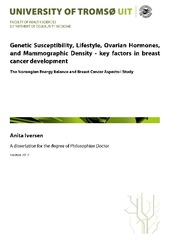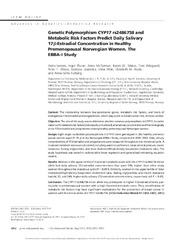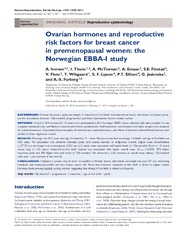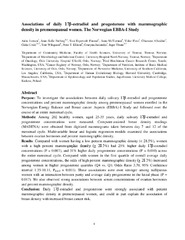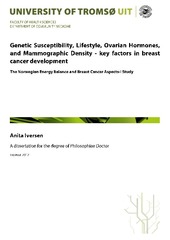| dc.contributor.advisor | Furberg, Anne-Sofie | |
| dc.contributor.author | Iversen, Anita | |
| dc.date.accessioned | 2014-10-23T08:39:20Z | |
| dc.date.available | 2014-10-23T08:39:20Z | |
| dc.date.issued | 2013-02-28 | |
| dc.description.abstract | Breast cancer is the most frequent cancer among women worldwide. Over the last century, the prevalence of overnutrition, overweight and obesity has increased, age at menarche has dropped and age at birth of first child has risen among women in Western countries. These trends may be linked to exposure to ovarian hormones that, in turn, may affect a woman’s lifetime risk of getting breast cancer.
The Norwegian Energy Balance and Breast cancer Aspects (EBBA)-I Study includes ovarian hormone data from complete menstrual cycles, blood samples, mammograms, clinical measurements, and lifestyle information from 204 healthy premenopausal women aged 25-35 years. The study is designed to explore biological mechanisms linking energy balance and hormonal exposures with breast cancer risk, and to identify new risk patterns of importance for prediction, prevention and treatment of breast cancer. The aim of this thesis was to study levels of endogenous estradiol and progesterone in relation to genetic susceptibility, metabolic and reproductive risk factors, and mammographic density, among healthy premenopausal women using data from the EBBA-I Study.
The results from the present analyses show that healthy premenopausal women with the CYP17 rs2486758 minor allele in combination with higher levels of metabolic risk factors had higher levels of estradiol across the menstrual cycle. Larger waist circumference and longer duration of past use of oral contraceptives were associated with higher levels of estradiol across the menstrual cycle among nulliparous women. Higher levels of estradiol and progesterone were strongly associated with higher mammographic density, particularly among nulliparous women. From our findings, we hypothesize that interventions to lower hormonal levels in premenopausal women could decrease mammographic density and improve the sensitivity of mammographic screening, both of which could improve breast cancer prevention. These interventions may be particularly important in premenopausal women before first full-term pregnancy and in a subgroup of women with a specific genetic marker. | en |
| dc.description.doctoraltype | dr.philos. | en |
| dc.description.popularabstract | Prosjektet er basert på analyser av data fra 204 friske kvinner i alderen 25-35 år som deltok i EBBA-I studien (2000-2002). Vi har brukt daglige målinger av kvinnelige kjønnshormoner gjennom menstruasjonssyklus, kliniske undersøkelser og informasjon om livsstil. Vi fant at høyt nivå av overvektsrelaterte risikofaktorer var forbundet med høyt nivå av østrogen hos kvinner med en genetisk variant i genet CYP17 (rs2486758). Større livvidde og lengre varighet av tidligere p-pillebruk var forbundet med høyere nivå av østrogen hos kvinner som ikke hadde født barn. Hos denne gruppen var også høyere nivå av både østrogen og progesteron sterkt assosiert med høyere mammografitetthet. Våre funn gir ny kunnskap om mulig sårbarhet – genetisk bakgrunn og livsfase kan trolig bestemme i hvilken grad nivå av kjønnshormoner hos unge kvinner blir påvirket av overvektsrelaterte risikofaktorer. Det vil videre være interessant å teste om livsstilsendringer kan redusere nivå av kjønnshormoner og derved også mammografitetthet hos unge kvinner, med relevans for forebygging av brystkreft. | en |
| dc.description.sponsorship | Foundation for the Norwegian Health and Rehabilitation Organizations grants 59010-2000/2001/2002; Norwegian Cancer Society grants 05087 and TP 49 258; Aakre Foundation grants 5695-2000 and 5754-2002; Northern Norway Regional Health Authority grant SFP-563-06; Norwegian research Council – 213997; PhD grant University of Tromsø | en |
| dc.description | This is a dr.philos. thesis. | |
| dc.identifier.uri | https://hdl.handle.net/10037/6757 | |
| dc.identifier.urn | URN:NBN:no-uit_munin_6357 | |
| dc.language.iso | eng | en |
| dc.rights.accessRights | openAccess | |
| dc.rights.holder | Copyright 2013 The Author(s) | |
| dc.rights.uri | https://creativecommons.org/licenses/by-nc-sa/3.0 | en_US |
| dc.rights | Attribution-NonCommercial-ShareAlike 3.0 Unported (CC BY-NC-SA 3.0) | en_US |
| dc.subject | VDP::Medisinske Fag: 700::Helsefag: 800::Epidemiologi medisinsk og odontologisk statistikk: 803 | en |
| dc.subject | VDP::Medical disciplines: 700::Health sciences: 800::Epidemiology medical and dental statistics: 803 | en |
| dc.title | Genetic Susceptibility, Lifestyle, Ovarian Hormones, and Mammographic Density – key factors in breast cancer development. The Norwegian Energy Balance and Breast Cancer Aspects-I Study. | en |
| dc.type | Doctoral thesis | en |
| dc.type | Doktorgradsavhandling | en |


 English
English norsk
norsk